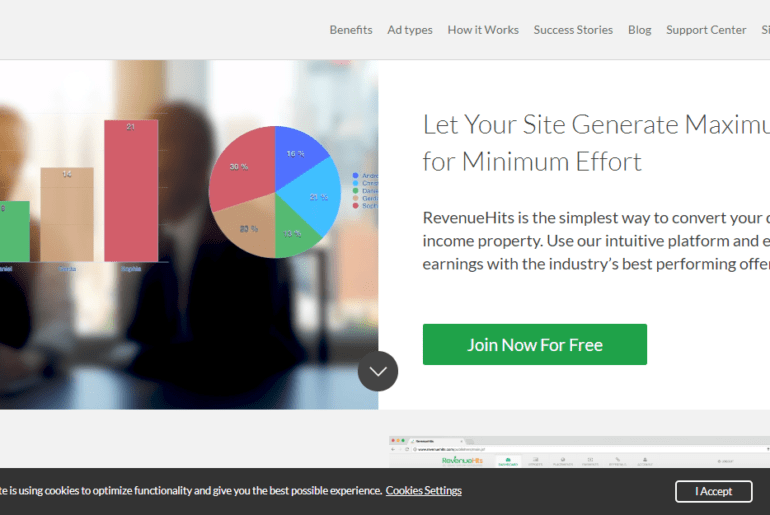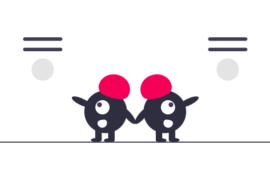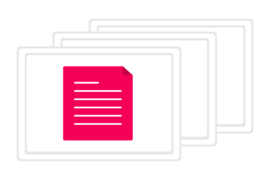Factsheet
- Founded in: 2008
- Supported model: CPA, CPM
- Payment method: PayPal, Payoneer, and Bank Wire
- Payment terms: Net-30
- Minimum payment threshold: $20 for PayPal and Payoneer, and $500 for Bank Wire
- Supported language: English
- Reporting: Dashboard with details of active ads
- Live publishers: 721 (as per SimilarTech)
- Minimum traffic: None
- Website: www.revenuehits.com
- Employee count: 51-200
Overview
RevenueHits is a self-service ad network by Intango LTD. The company was founded in 2008 with the idea to help web publishers monetize their digital assets, and get the best value for their ad space.
Since then, they have worked with over 20K publishers and 5K advertisers. With more than 3 billion impressions a day, RevenueHits claims to offer a 100% fill rate on all geographies. They also have an ad-block solution that helps publishers recover the money lost due to users installing adblocking software.
Also, RevenueHits work with only clean ads – users won’t find ads for inappropriate content, hacking, gambling, and other offensive ads on the website.
RevenueHits supports a wide range of display ad formats for desktop and mobile devices. Some of the recommended ad formats are discussed below:
- Display banners: The standard display ads come in varied sizes such as leaderboard, skyscraper, medium rectangle, etc. These can be placed in different areas on a page and can be static or animated.
- Popunder: The popunder opens an ad window behind the existing browser window – making it visible only when the user closes the window or tab. This offers a better viewability to ads and in turn, gets a better revenue for publishers.
- In page push: This looks like a push notification on the web browsers, hence, works on both desktop and mobile devices (including iOS).
- Footer sticky: A footer ad consists of a banner that is displayed horizontally across the bottom of the viewed section of a webpage. The footer maintains its position in the browser as the user scrolls down the page.
- Floating banner: A full-screen ad that is displayed at natural transition points in the flow of the editorial content structure – such as between two content pages.
- Shadow box: An opaque box that appears in the middle of the screen, displaying the ad. This ad type is known to fight banner blindness by ensuring impressions from users.
These were some of the popular ones, RevenueHits has more display ad formats for publishers to test.
Pros
AdSense alternative: For publishers looking for an AdSense alternative, RevenueHits serves the purpose. This ad network can also be used in parallel with AdSense. The latter method is more recommended as this can help you increase bid pressure on your inventory and get better CPMs.
Cost per action model: RevenueHits offers a CPA (cost per action) model – publisher may earn money not only on impressions or clicks but when an action is made by your visitors. An action can be a sale, contact request, newsletter sign up, registration, filling out a survey, etc. This can be ideal for publishers with varied business models such as e-commerce, subscription plans, and others.
Partnerships with 5000+ advertisers: They have a wide range of in-house advertisers who are ready to buy publishers’ traffic without commission (accepted by DSPs and servers), allowing them to get competitive rates in the industry.
Publisher control and transparency: Since this a self-serve platform (just like AdSense), publishers are able to add/remove ad units as per their convenience. Apart from that, the account manager at RevenueHits can help publishers optimize their placement up-to some extent, however, the end control always remains in publishers’ hands.
Cons
No real-time reporting: Real-time reports are not possible using their dashboard. However, publishers can see the performance report for all active ad units for the previous day.
Only supports display ads: The ad format supported by RevenueHits includes a display and animated placements. For other formats like video ads and innovative ads, publishers would have to look for other solutions.
Can’t bring your own demand: Publishers are not allowed to integrate their own demand partners and make them compete with RevenueHits. This stops publishers from comparing the performance of RevenueHits advertisers and other leading demand partners in ad tech.
Note: If you wish to make RevenueHits or other ad networks compete with your own demand partners, then we recommend using Google Ad Manager (DFP).
How to Get Started
As mentioned above, RevenueHits is a self-serve ad network. To get started, publishers can simply signup and follow these three steps:
- Create a placement: Fill in your name and the website where the ads will be displayed. Then start by selecting the device, ad type, and size for an ad unit.
- Implement tag: Copy your code and paste it into the source code of your site. On the dashboard, you choose the ‘Preview’ feature to see how the ads will appear on the site before finally making changes.
- Track and analyze: Review the dashboard reports for impressions, clicks, eCPM, and revenue per customer time to update the placements.
RevenueHits takes care of the payment for publishers, once the threshold is reached, publishers can see the expected payment in their dashboard.

Shubham is a digital marketer with rich experience working in the advertisement technology industry. He has vast experience in the programmatic industry, driving business strategy and scaling functions including but not limited to growth and marketing, Operations, process optimization, and Sales.







